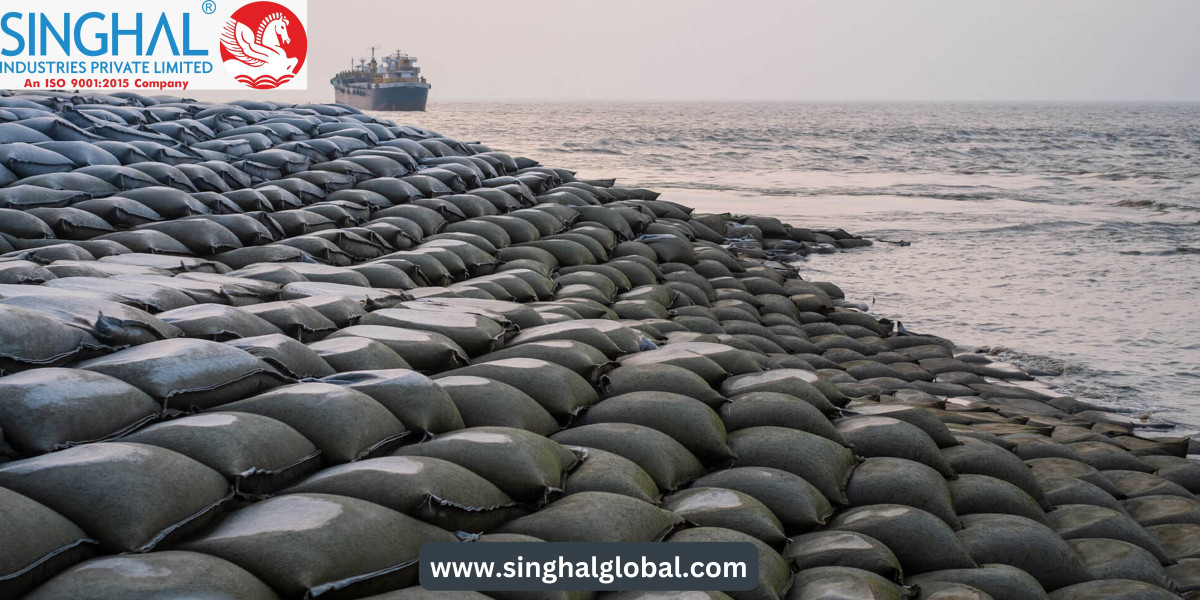Geo Bags, also known as geotextile bags, are gaining popularity for their role in preventing erosion and protecting shorelines. Geotextile Bags Price in Ahmedabad, filled with sand or other materials, are designed to stabilize areas prone to soil erosion and water damage. In this comprehensive guide, we will explore everything you need to know about geo bags, their uses, and how they contribute to environmental protection.
Introduction to Geo Bags
Definition and Purpose of Geo Bags
Geo Bags are robust, permeable fabric bags typically filled with materials like sand or gravel. These bags are used to combat erosion, especially in areas near water bodies. They are designed to absorb the impact of water flow and stabilize the shoreline, preventing further degradation of land.
Types of Geo Bags Available
Geo Bags come in various sizes and materials depending on the specific project requirements. Some are woven from synthetic fibers, while others use natural biodegradable materials for temporary installations.
Why Geo Bags Are Important for Erosion Control
How Geo Bags Prevent Soil Erosion
By acting as a barrier against water flow, Geo Bags help to prevent soil from washing away. They reduce the velocity of water, allowing it to seep through gradually rather than washing over vulnerable shorelines.
Geo Bags vs. Traditional Erosion Control Methods
Compared to traditional methods like rock riprap or concrete revetments, Geo Bags offer a more flexible and cost-effective solution. Their ease of installation and ability to conform to the natural terrain make them ideal for many projects.
The Role of Geotextile Bags in Coastal Protection
How Geotextile Bags Protect Shorelines
Geo Bags act as a buffer between the land and the ocean or river, absorbing the energy from waves and currents. This prevents the shoreline from eroding and losing valuable land mass.
Case Studies of Successful Geo Bag Installations
Several coastal regions have successfully used Geo Bags to protect their shorelines. For instance, a recent project along a riverbank in Bangladesh demonstrated significant reductions in erosion after the installation of Geo Bags.
Understanding Geo Bags Pricing
Factors Influencing Geotextile Bags Price
The price of Geo Bags varies depending on factors such as size, material, and location. Larger projects may require custom-sized Geo Bags, increasing costs.
Comparing Costs: Geo Bags vs. Alternatives
Although Geo Bags may initially seem more expensive than some alternatives, their long-term durability and minimal maintenance requirements often make them a more cost-effective solution.
Eco-Friendly Benefits of Geo Bags
Environmental Impact of Geo Bags
Geo Bags are an environmentally friendly option for erosion control because they minimize the need for heavy machinery and reduce habitat disruption. The materials used in the bags are also designed to integrate naturally into the environment over time.
Sustainability of Using Geo Bags
How to Choose the Right Geo Bag for Your Project
Key Considerations When Selecting Geo Bags
When choosing Geo Bags, factors such as water flow, soil type, and project size should be considered. For areas with high water flow, more durable materials and larger bags may be necessary.
Geo Bags for Small vs. Large-Scale Projects
For small-scale projects, such as residential erosion control, smaller Geo Bags are sufficient. However, larger projects, such as riverbank protection, require reinforced, high-capacity Geo Bags to withstand intense conditions.
Installation Process of Geo Bags
Step-by-Step Guide to Geo Bag Installation
Assess the area for erosion.
Prepare the site by clearing debris.
Place Geo Bags along the shoreline or slope.
Fill the bags with appropriate material (e.g., sand or gravel).
Secure the bags in place to prevent shifting.
Common Mistakes to Avoid During Installation
Failing to properly fill the Geo Bags with adequate material.
Not securing the bags firmly, leading to movement during storms.
Installing bags too far apart, reducing effectiveness.
Geo Bags for Erosion Control
How Geo Bags Mitigate Erosion
Geo Bags slow down water flow and absorb its energy, preventing soil displacement. They also create a natural-looking barrier that blends into the landscape while providing robust erosion control.
Long-Term Benefits of Geo Bags in Erosion Management
Over time, Geo Bags promote vegetation growth in eroded areas, further stabilizing the soil. This long-term benefit reduces the need for ongoing erosion control efforts.
Geo Bags for Waterway Protection
The Importance of Geo Bags in Riverbank Protection
Riverbanks are highly susceptible to erosion due to constant water flow. Geo Bags provide a protective layer that helps maintain the integrity of the riverbank and prevents sediment from being washed away.
How Geo Bags Reduce Sediment Build-Up in Waterways
Geo Bags trap sediment and slow down water flow, reducing the amount of debris that enters rivers and lakes. This keeps waterways cleaner and reduces the risk of flooding downstream.
Geo Bags for Flood Prevention
How Geo Bags Help Control Flooding
By stabilizing riverbanks and shorelines, Geo Bags reduce the risk of flooding. In urban areas, they are increasingly used to manage floodwaters and protect infrastructure.
Geo Bags in Urban Flood Management Projects
Geo Bags are being implemented in cities around the world as part of flood control systems. Their flexibility and ease of installation make them ideal for rapidly growing urban environments.
Maintenance of Geo Bags
Best Practices for Maintaining Geo Bags
Regular inspections should be conducted to ensure the bags remain secure and undamaged. Minor adjustments may be necessary over time to keep the bags in optimal condition.
When to Replace Geo Bags
Depending on environmental factors, Geo Bags may last several years before needing replacement. It’s essential to monitor for wear and tear, especially in high-flow areas.
Geo Bags vs. Other Erosion Control Products
Comparing Geo Bags with Riprap, Gabions, and Revetments
While riprap and gabions are commonly used for erosion control, Geo Bags offer unique advantages, such as ease of installation and flexibility in different environments.
Cost-Effectiveness and Performance Comparison
Geo Bags are often more cost-effective in the long run, requiring less maintenance than other solutions. Their performance is also highly reliable in most erosion-prone areas.
Common Myths About Geo Bags
Debunking Myths About Geo Bags' Durability
Despite misconceptions, Geo Bags are incredibly durable and capable of withstanding harsh environmental conditions. With proper maintenance, they can last for decades.
Clarifying Misconceptions About Geo Bags' Environmental Impact
Some believe that Geo Bags harm the environment, but in reality, they are designed to work harmoniously with natural ecosystems, reducing erosion and promoting plant growth.
Future of Geo Bags in Environmental Protection
Technological Advances in Geo Bag Materials
New materials are being developed to enhance the strength and longevity of Geo Bags for Erosion Control. These innovations promise even greater performance in erosion control projects.
Emerging Trends in Geo Bag Applications
As awareness of climate change grows, Geo Bags are increasingly being used in flood management and coastal defense projects around the world.
FAQs
What are the most common uses for Geo Bags?
Geo Bags are primarily used for erosion control, flood prevention, and coastal protection. They are also used in riverbank stabilization and waterway management.
How long do Geo Bags last?
Geo Bags can last anywhere from 10 to 50 years, depending on environmental conditions and maintenance.
Are Geo Bags biodegradable?
Some Geo Bags are biodegradable, designed to break down naturally over time, while others are made from long-lasting synthetic materials.
Can Geo Bags be reused?
In some cases, Geo Bags can be repositioned and reused, but this depends on the specific application and condition of the bags.
What materials are used to fill Geo Bags?
Geo Bags are typically filled with sand, gravel, or other locally available materials that provide stability and weight.







